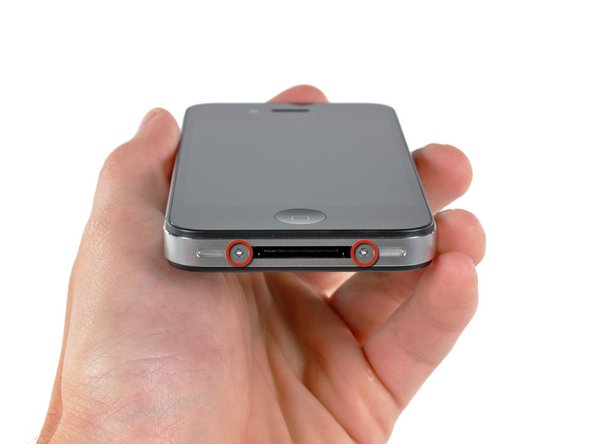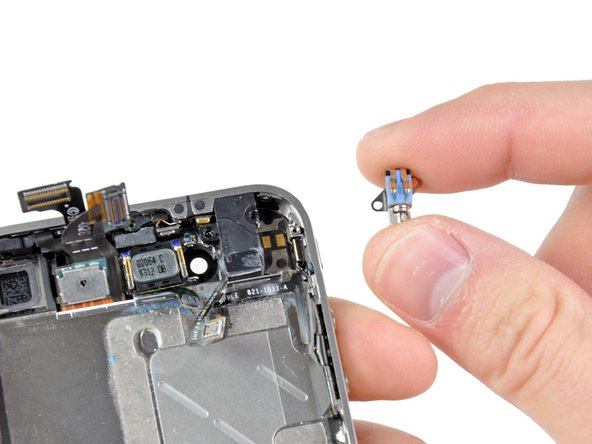Esta versión puede contener ediciones incorrectas. Cambie a la última instantánea verificada.
Qué necesitas
-
-
La caja posterior de tu iPhone 4 puede fijarse bien con dos tornillos Phillips #000 o bien con tornillos Apple de 5-Puntos (segunda imagen). Comprueba cuáles tienes y asegúrate de que tienes el destornillador adecuado para retirarlos.
-
Retira los dos tornillos Pentalobe o Phillips #000 de 3.6 mm que están junto al conector para el cargador.
-
-
-
Remueve el único tornillo de 2.5 mm Phillips que asegura el conector de la batería a la tarjeta lógica.
-
-
-
Usa la pestaña de plástico clara para levantar gentilmente la batería fuera del iPhone.
-
Si hay solución de alcohol restante en el teléfono, límpialo cuidadosamente o permite que se seque antes de instalar la batería nueva.
-
Antes de reconectar el conector de la batería, asegúrate que el clip de contacto (mostrado en rojo) este propiamente posicionado a lado del conector de la batería.
-
-
Este paso está sin traducir. Ayuda a traducirlo
-
Use a SIM card eject tool or a paperclip to eject the SIM card and its holder.
-
Remove the SIM card and its holder.
-
-
Este paso está sin traducir. Ayuda a traducirlo
-
Remove the following two screws:
-
One 1.2 mm Phillips
-
One 1.6 mm Phillips
-
Remove the thin steel dock connector cable cover from the iPhone.
-
-
Este paso está sin traducir. Ayuda a traducirlo
-
Use an iPod opening tool to gently pry the dock cable connector up off the logic board from both short ends of the connector.
-
-
-
Este paso está sin traducir. Ayuda a traducirlo
-
Carefully peel the dock ribbon cable off the logic board and the lower speaker enclosure.
-
-
Este paso está sin traducir. Ayuda a traducirlo
-
Use a plastic opening tool to pry the lower antenna connector up off its socket on the logic board.
-
-
Este paso está sin traducir. Ayuda a traducirlo
-
Remove the 1.9 mm Phillips screw securing the bottom of the logic board to the inner case.
-
-
Este paso está sin traducir. Ayuda a traducirlo
-
Remove the following five screws securing the Wi-Fi antenna to the logic board:
-
One 2.3 mm Phillips
-
Two 1.6 mm Phillips
-
One 1.4 mm Phillips
-
One 4.8 mm Phillips
-
-
-
Utilice una herramienta de apertura de iPod para desprender con cuidado la tapa de la antena Wi-Fi de la tarjeta lógica.
-
Insertar traducción aquí
-
Remueva la antena Wi-Fi del iPhone. Procure no extraviar los clips de metal de la tapa superior donde ajustan los tornillos de 4.8 mm. Esta es la causa por la que regularmente hay fallos en la señal inalámbrica cuando se reensambla.
-
-
Este paso está sin traducir. Ayuda a traducirlo
-
Use the edge of a plastic opening tool to gently pry the following connectors up and out of their sockets on the logic board:
-
Digitizer cable (pry from bottom)
-
LCD cable (pry from bottom)
-
Headphone jack/volume button cable (pry from top)
-
Top Microphone/sleep button cable (pry from top)
-
Front camera cable (pry from top)
-
-
Este paso está sin traducir. Ayuda a traducirlo
-
Remove the 4.8 mm standoff screw near the headphone jack.
-
Without this part, the motherboard could damage the ribbon cables around it.
-
-
Este paso está sin traducir. Ayuda a traducirlo
-
Carefully remove the logic board from the iPhone, minding any cables that may get caught.
-
-
Este paso está sin traducir. Ayuda a traducirlo
-
Use the edge of a plastic opening tool to lift the thin steel front camera retainer off the front camera.
-
Remove the front camera retainer.
-
-
Este paso está sin traducir. Ayuda a traducirlo
-
Carefully lift the front facing camera out of the iPhone.
-
-
Este paso está sin traducir. Ayuda a traducirlo
-
Remove the following two screws securing the vibrator to the inner frame:
-
One 6 mm Phillips
-
One 1.4 mm Phillips
-
Remove the vibrator from the inner case.
-
-
Este paso está sin traducir. Ayuda a traducirlo
-
Use the edge of a plastic opening tool to pry the earpiece speaker away from the adhesive securing it to the front panel.
-
-
Este paso está sin traducir. Ayuda a traducirlo
-
Remove the two Phillips #000 screws securing the power button bracket to the outer case.
-
Carefully pull the power button bracket up and out of the outer case.
-
-
Este paso está sin traducir. Ayuda a traducirlo
-
Use a pair of tweezers to pull the body of the headphone jack out of the outer case.
-
-
Este paso está sin traducir. Ayuda a traducirlo
-
Grab the power & sensor cable near the microphone and peel it off the front panel, being careful not to rip it in the process.
-
-
Este paso está sin traducir. Ayuda a traducirlo
-
Also be sure to transfer the proximity sensor foam/UV-filter adhered to the old power & sensor cable if your new one does not already come with one. It looks like a small square and can be peeled off with tweezers.
-
Transfer the bracket to your new power & sensor cable.
-
Cancelar: No complete esta guía.
509 personas más completaron esta guía.
Documentos Adjuntos
24 comentarios
I replaced the Home button and the Power & Sensor cable, along with battery. Let me explain some caveats with ifixit's parts (OEM Apple parts):
-The power-sensor part does not include a new gasket/filter for the sensor- recommend tweezers and care.
-The power-sensor cable needs the foam pad transferred with the adhesive- extreme care with removal.
-IF the power button isn't working it is likely the cable, not the button.
-I used a small ice cube tray.
-It took me an hour (I had to get up and walk away...frustration factor high with the delicate flex cables and adhesive). Lit magnifier is welcome. Definitely use a spudge stick.
-I broke 2 of the 4 shield/antenna tabs that you need to tuck down from the speaker on re-assembly. I didn't force them, but so easy to press too hard in seating the speaker.
- I do repairs on a grounded-ESD mat and wore wriststrap.
-Right screw on the power button brace is PITA to access...careful pressing on the display flex cables to access the tiny screw. Magnetize your bit!
Great guide and perfect web site. It is extremely easy to find what you are looking for and order the components you need.











































